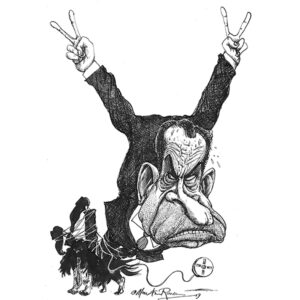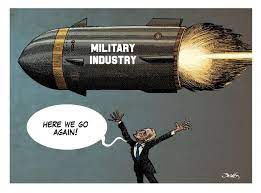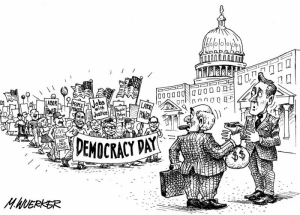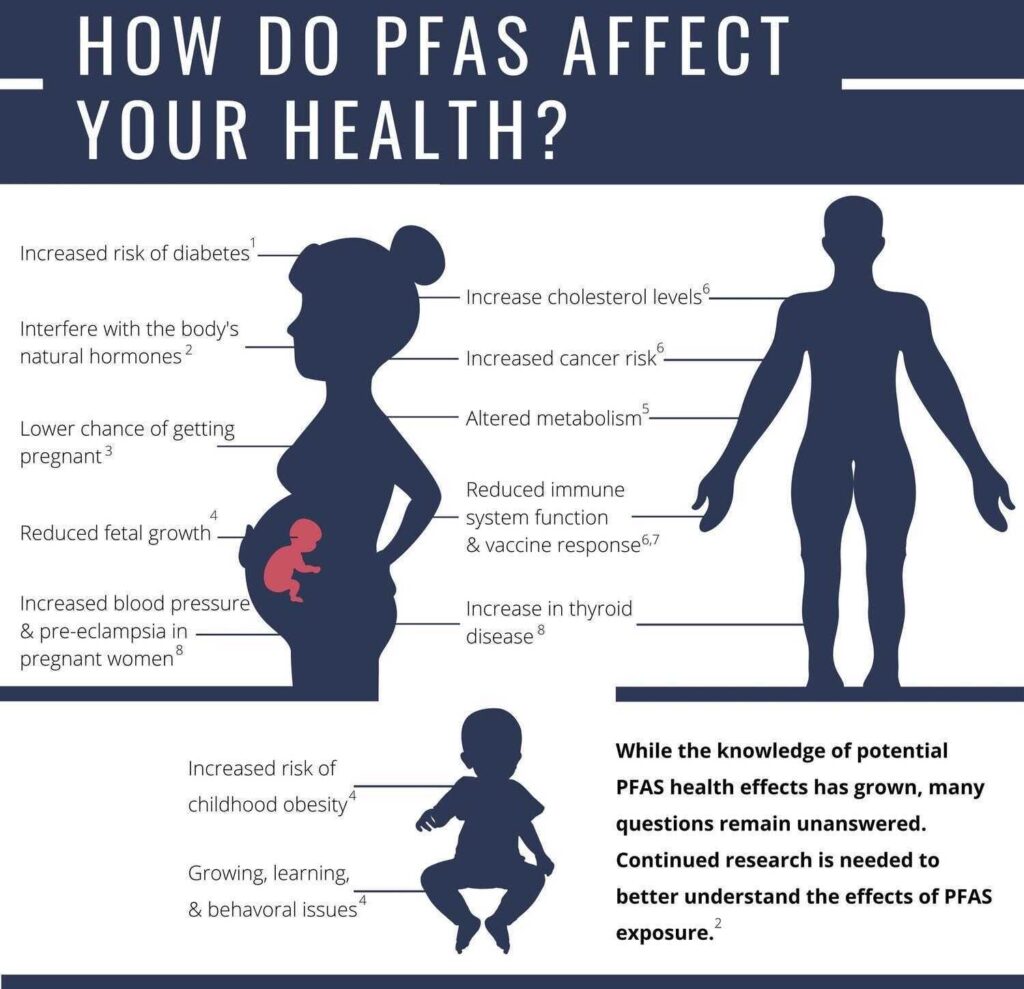This is not the way we put the end to war.

“…the only way to achieve a practical, livable peace in a world of competing nations is to take the profit out of war.” – Richard Nixon
Real Peace (1983)
War Profiteering Statistics and Data
- Costs of War Project and Watson Institute for International and Public Affairs ~ Brown University ~
- SIPRI: Stockholm International Peace Research Institute
- Cost of National Security: Counting How Much the U.S. Spends Per Hour (nationalpriorities.org)

“That the U.S./NATO-instigated war in Ukraine could result in a third world war is of major concern for all of humanity, especially workers and oppressed people who ultimately bear the brunt of any war. Yet for some global billionaires — today’s ‘masters of war’ — this conflict is seen as an opportunity to further boost profits.
Among those already reaping gains are companies involved in the production and sale of weapons, planes and other military hardware. This includes 14 of the world’s 20 largest “defense” companies headquartered in the U.S. Topping this list are Lockheed Martin, Boeing and Raytheon Technologies, which had combined arms sales in 2019 nearing $100 billion.
On Feb. 24, the day Russia invaded Ukraine, the stock value of these arms manufacturers soared. Raytheon and Lockheed officials openly told investors the Ukraine conflict was “good for business.” In a company “earnings call,” issued Jan. 25, Raytheon CEO Greg Hayes described how they could benefit from the conflict. Similarly, Lockheed CEO James Taiclet told investors the “great power competition [between the U.S. and Russia] over Ukraine bodes more business for the company…”
Lockheed And Raytheon – Today’s ‘Masters Of War’ – PopularResistance.Org
Abolish the CIA (rootsaction.org) Petition to abolish the secret government and gangsters in the CIA.

“As the United States weighs more involvement in the growing conflict between Ukraine and Russia, some of the largest weapons companies in the world — Raytheon and Lockheed Martin — are openly telling their investors that tensions between the countries are good for business. And General Dynamics, meanwhile, is boasting about the past returns the company has seen as a result of such disputes.
The statements come as the U.S. government escalates arms shipments to Ukraine, among them the Javelin missiles that are a joint venture between Raytheon and Lockheed Martin. House Democrats, meanwhile, are trying to quickly push through a bill that would significantly increase U.S. military assistance to Ukraine, and impose new sanctions on Russia.
Anti-war campaigners warn that U.S. escalation, amid renewed tensions between Ukraine and Russia, could bring dire consequences, and spill into a much larger and more protracted war. “As we are shipping advanced weaponry to the Ukrainian military, the Biden administration has signaled that U.S. military advisors will continue to stay in the country,” Cavan Kharrazian, progressive foreign policy campaigner for the advocacy organization Demand Progress, tells In These Times. “Who will most likely set up and teach the Ukrainian army how to use these weapons systems? The U.S. military…”
Top Weapons Companies Boast Ukraine-Russia Tensions Are a Boon for Business – In These Times
“International transfers of major arms saw a slight drop between 2012–16 and 2017–21 (–4.6 per cent). Nevertheless, exports by the United States and France increased substantially, as did imports to states in Europe (+19 per cent), East Asia (+20 per cent) and Oceania (+59 per cent). Transfers to the Middle East remained high, while those to Africa and the Americas decreased, according to new data on global arms transfers published today by the Stockholm International Peace Research Institute (SIPRI).
‘The small decrease in global arms transfers masks large variations between regional trends,’ said Pieter D. Wezeman, Senior Researcher with the SIPRI Arms Transfers Programme. ‘Whereas there were some positive developments, including South American arms imports reaching their lowest level in 50 years, increasing or continuing high rates of weapons imports to places like Europe, East Asia, Oceania and the Middle East contributed to worrying arms build-ups.’
Europe sees biggest growth in arms imports
The biggest growth in arms imports among world regions occurred in Europe. In 2017–21 imports of major arms by European states were 19 per cent higher than in 2012–16 and accounted for 13 per cent of global arms transfers. The largest arms importers in Europe were the United Kingdom, Norway and the Netherlands. Other European states are also expected to increase their arms imports significantly over the coming decade, having recently placed large orders for major arms, in particular combat aircraft from the USA. Despite armed conflict in eastern Ukraine throughout 2017–21, the country’s imports of major arms in the period were very limited.
‘The severe deterioration in relations between most European states and Russia was an important driver of growth in European arms imports, especially for states that cannot meet all their requirements through their national arms industries,’ said Pieter D. Wezeman, Senior Researcher with the SIPRI Arms Transfers Programme. ‘Arms transfers also play an important role in transatlantic security relationships”
Global arms trade falls slightly, but imports to Europe, East Asia and Oceania rise | SIPRI

“Since 9/11, U.S. media, politicians, and security experts have produced a deluge of pro-war content, establishing and further normalizing a paradigm that treats war-making as the natural response to terror attacks. At the same time, research has shown that government violence against people in the name of counterterrorism, wartime destruction of infrastructure, and long-term U.S. military presence abroad breed ill-will toward the United States and broaden support for the same groups that the U.S. post-9/11 wars officially aim to eliminate.
By reviewing a wide range of relevant literature from scholars and think tanks, this paper explores some of the most robust non-military models of counterterrorism and outlines eleven paradigms and the implicit assumptions of the states and experts who employ them about the problem of terrorism. The accompanying infographic separates state-led models of counterterrorism into the categories of “coercive,” “proactive,” “persuasive,” “defensive,” and “long-term.”
Deaths caused by governments in the name of counterterrorism vastly exceeds deaths caused by militant groups who use terror tactics. Between 1995 and 2019, the National Consortium for the Study of Terrorism and Responses to Terrorism (START) calculated that 3,455 U.S. citizens were killed in terror attacks. In contrast, Costs of War data has shown that the U.S. post-9/11 wars have directly killed over 929,000 people. Meanwhile, between 2001 and 2021, the U.S. poured $8 trillion into counterterrorism warfare.
website… https://madisonvfp.org/
facebook… https://www.facebook.com/groups/madisonvfp
twitter… https://twitter.com/MadisonVfp
@MadisonVfp
Oh, I marched to the battle of New Orleans
At the end of the early British wars
The young land started growing
The young blood started flowing
But I ain’t marching anymore
For I’ve killed my share of Indians
In a thousand different fights
I was there at the Little Big Horn
I heard many men lying, I saw many more dying
But I ain’t marching anymore
It’s always the old to lead us to the wars
It’s always the young to fall
Now look at all we’ve won with the saber and the gun
Tell me, is it worth it all?
For I stole California from the Mexican land
Fought in the bloody Civil War
Yes, I even killed my brothers
And so many others
But I ain’t marching anymore
For I marched to the battles of the German trench
In a war that was bound to end all wars
Oh, I must have killed a million men
And now they want me back again
But I ain’t marching anymore
It’s always the old to lead us to the wars
Always the young to fall
Now look at all we’ve won with the saber and the gun
Tell me, is it worth it all?
For I flew the final mission in the Japanese skies
Set off the mighty mushroom roar
When I saw the cities burning
I knew that I was learning
That I ain’t marching anymore
Now the labor leader’s screamin’
When they close the missile plants
United Fruit screams at the Cuban shore
Call it peace or call it treason
Call it love or call it reason
But I ain’t marching anymore
No, I ain’t marching anymore
By David Swanson, World BEYOND War
“Propaganda is most impactful when people don’t think it’s propaganda, and most decisive when it’s censorship you never knew happened. When we imagine that the U.S. military only occasionally and slightly influences U.S. movies, we are extremely badly deceived. The actual impact is on thousands of movies made, and thousands of others never made. And television shows of every variety.
The military guests and celebrations of the U.S. military on game shows and cooking shows are no more spontaneous or civilian in origin than the ceremonies glorifying members of the U.S. military at professional sports games — ceremonies that have been paid for and choreographed by U.S. tax dollars and the U.S. military. The “entertainment” content carefully shaped by the “entertainment” offices of the Pentagon and the CIA doesn’t just insidiously prepare people to react differently to news about war and peace in the world. To a huge extent it substitutes a different reality for people who learn very little actual news about the world at all.”

follow the money
ban bribery
demand transparency










